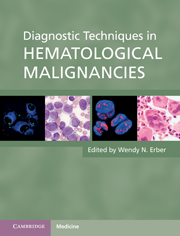Book contents
- Frontmatter
- Contents
- List of Contributors
- Preface
- Part 1 Diagnostic techniques
- Part 2 Hematological malignancies
- 6 The integrated approach to the diagnosis of hematological malignancies
- 7 Acute lymphoblastic leukemia
- 8 Acute myeloid leukemia
- 9 Mature B-cell leukemias
- 10 Mature T-cell and natural-killer cell leukemias
- 11 Lymphoma
- 12 Plasma cell neoplasms
- 13 Chronic myeloid leukemia
- 14 Myeloproliferative neoplasms
- 15 Myelodysplastic syndromes and myelodysplastic/myeloproliferative neoplasms
- Index
- References
11 - Lymphoma
from Part 2 - Hematological malignancies
Published online by Cambridge University Press: 06 December 2010
- Frontmatter
- Contents
- List of Contributors
- Preface
- Part 1 Diagnostic techniques
- Part 2 Hematological malignancies
- 6 The integrated approach to the diagnosis of hematological malignancies
- 7 Acute lymphoblastic leukemia
- 8 Acute myeloid leukemia
- 9 Mature B-cell leukemias
- 10 Mature T-cell and natural-killer cell leukemias
- 11 Lymphoma
- 12 Plasma cell neoplasms
- 13 Chronic myeloid leukemia
- 14 Myeloproliferative neoplasms
- 15 Myelodysplastic syndromes and myelodysplastic/myeloproliferative neoplasms
- Index
- References
Summary
Introduction
The cornerstone of the diagnosis of lymphoma is the architectural pattern and cytology of the lesion in the affected tissue and this is supplemented by immunophenotypic, molecular and cytogenetic characteristics. These features together define our modern classification scheme of lymphoma. These same investigations are utilized in the assessment of bone marrow involvement by lymphoma, but with some variations and limitations. The role of bone marrow examination varies according to the subtype of lymphoma. This chapter will provide the general principles and practical guidelines of the most useful diagnostic techniques for the detection of bone marrow involvement by malignant lymphomas. It will detail the typical features and roles of morphology, immunohistochemistry, flow cytometric immunophenotyping, cytogenetic and molecular testing in different types of lymphoma. The existence of significant variations from the classical description will be identified by “caveats.” Disease monitoring and pre-transplant assessment will be discussed where applicable. Acronyms used for the various entities are listed in Table 11.1.
General principles of bone marrow evaluation in lymphoma
Bone marrow examination is routinely performed for lymphoma staging. A bone marrow may also be performed as an ad hoc diagnostic procedure in patients suspected of having a neoplasm lymphoma but who are not deemed suitable for a surgical biopsy of the implicated tissue lesion (e.g. thrombocytopenia, anticoagulation, unsuitable for general anesthesia). In many specimens malignancy (hematopoietic or non-hematopoietic) and cell lineage can be established. However, accurate sub-typing may require correlation with a tissue biopsy.
- Type
- Chapter
- Information
- Diagnostic Techniques in Hematological Malignancies , pp. 206 - 243Publisher: Cambridge University PressPrint publication year: 2010
References
- 1
- Cited by



